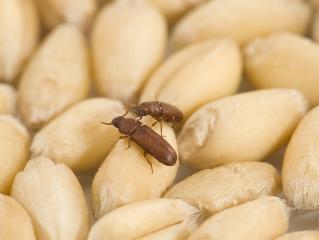Grain pests (insects and disease)
Insects
Many grain pests preferentially eat out grain embryos, lowering the percentage of seeds which germinate.
Freshly-harvested cereal grain usually has a temperature around 30°C, which is an ideal breeding temperature for storage pests
| Grain temperature (°C) | Insect/mould development | Grain moisture content (%) |
|---|---|---|
| 40-55 | Seed damage occurs, reducing viability | - |
| 30-40 | Mould and insects prolific | >18 |
| 25-30 | Mould and insects active | 13-18 |
| 20-25 | Mould development is limited | 10-13 |
| 18-20 | Young insects stop developing | 9 |
| <15 | Most insects stop reproducing, mould stops developing | <8 |
For more information refer to Insect pests of stored grain and GRDC factsheets Identification of stored grain pests and Grain storage pest control guide.
Diseases
Fungal diseases affecting grain viability include fusarium head blight and white grain disorder (caused by Tiarosporella spp.) Both of these are quite rare and occur when wet springs promote infection during flowering.

